Transforming a baseball stadium into a football one: Turner Field becomes Georgia State's home
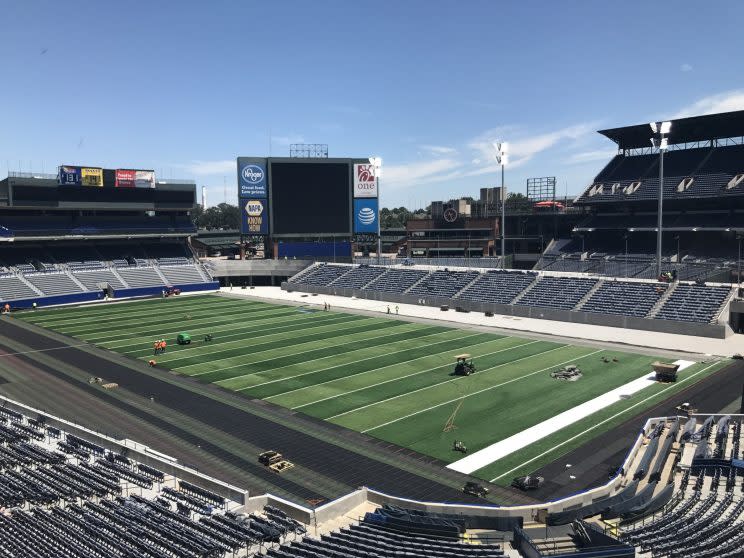
ATLANTA—At first glance, your brain refuses to accept what your eyes behold, like seeing, say, Tim Tebow in a baseball uniform. There, in the middle of Turner Field, the 20-year home of the Atlanta Braves, sits a gargantuan … football field?
It’s true. At the end of this month, the Georgia State University Panthers will take the field against Tennessee State at their new home, and Atlanta fans showing up for games will have the world’s most severe case of déjà vu.
The mound where Smoltz, Glavine, and Maddux once owned the National League is gone. The infield dirt that Chipper Jones used to patrol, gone. The dugout steps where Bobby Cox questioned the ancestry of a thousand umpires … gone, all gone. The Braves have packed up and left for a shiny new palace a dozen miles up Interstate 75, leaving behind a stadium so new that its first event was the 1996 Olympic Games.
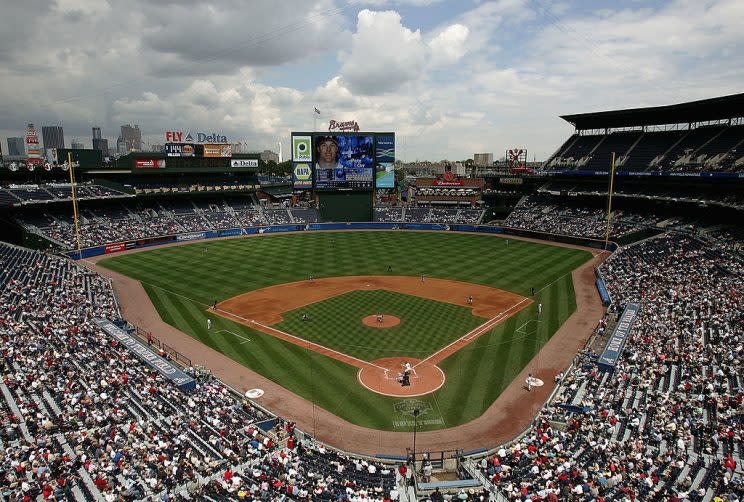
The Braves’ move said a lot about the business of sports in the 21st century, a time when public-private cooperation looks less like a poker game and more like a hostage negotiation. The Braves’ departure from Turner Field drew sharp nationwide criticism, but it’s going to pay off handsomely for the team long after rage has faded. The team ditched Turner Field in large part because it didn’t own the property, the major-league equivalent of leaving your trendy in-town rental for a place in the suburbs. And the city of Atlanta, already scrambling to help fund a new Falcons stadium and a renovated Hawks arena, wouldn’t kick in any more money to rework Turner Field to the Braves’ liking.
Thing is, while a landlord can flip an apartment easily enough, finding another occupant for a world-class stadium is another matter. By a stroke of good fortune, Georgia State, located just north of Turner Field, was looking to expand its footprint in the city, and found itself with an ideal opportunity: take over a baseball stadium and convert it into a football one.
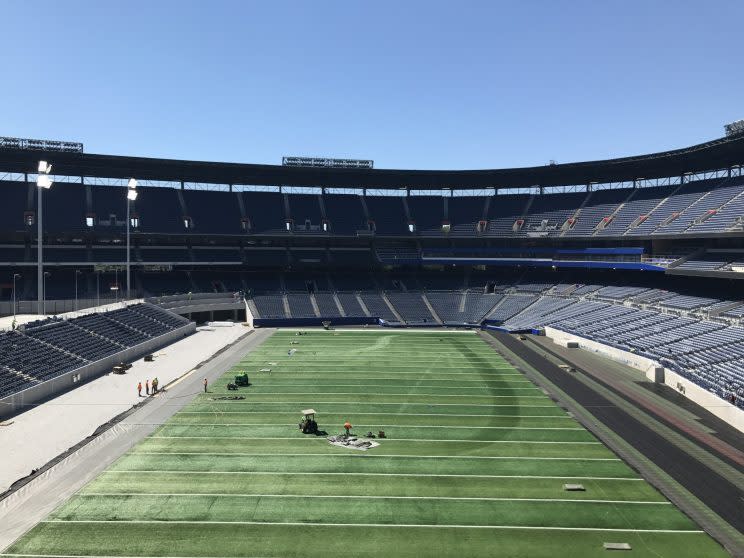
Georgia State announced its intentions to take over the stadium back in 2014, and closed on the deal in 2016. Once the Braves wrapped the 2016 season, work began in earnest to fit a rectangular field into an octagonal hole. Working off several different budgets, starting with $26 million to prepare the field for football, Georgia State started construction in late February and is now within days of completion. Another $6 million to $8 million in so-called “back of the house” improvements at what’s now known as Georgia State Stadium will take place over the course of the next few months.
The field and the seats don’t sync up perfectly; baseball seats are intended to face home plate, and in this configuration, that points fans at the southwest corner of the field. But a newly-constructed grandstand of about 2,500 seats removed from other sections of the stadium stretches along the east sideline in what was once shallow right field, running roughly parallel to the line between first and second base. Behind that grandstand, the old right-field seats arc off uselessly. (The university had considered removing that entire section of the stadium, but the costs associated with both demolition and, if necessary, subsequent construction killed that idea.)
Georgia State had to remove the dugouts and about seven rows of seats to set up the best sight lines. Crews also had to lop off rows beyond what was left-field fence to ensure there was enough room. The result: not only a regulation-size football field, but a space with enough room to meet FIFA regulations for soccer as well. Not only that, the new configuration allows for a stage setup in left field—sorry, the north end zone; this’ll take a little while to get used to—so that the stadium can host concerts and other events.
Seating capacity in the new configuration will be about 25,000, expandable to 33,000 for football and 42,000 for concerts. The upper-deck seats won’t be sold for football games, not immediately, but Georgia State hopes that the games become enough of a draw that those seats become viable sales.
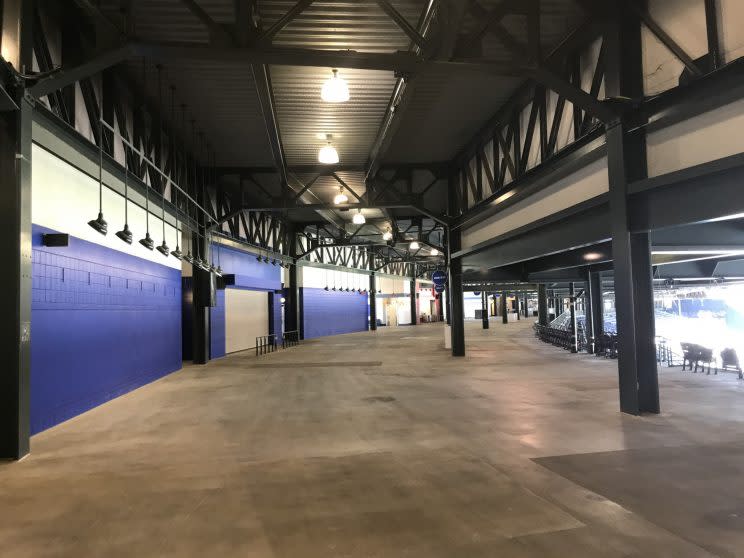
Across the stadium, crews are slathering a fresh coat of paint—PMS 286, the university’s preferred shade of blue—over the Braves’ deep blues. The “Chop House,” the deep-centerfield hangout that was once the haven of beer-soaked postcollegiate Braves fans, will become the “State House.” The executive-level 755 Club, named for Hank Aaron’s career home run total, will become The University Club. (Try to ignore the baseballs embossed into the wood of the “Touchdown Lounge.”)
The few symbols of the Braves still remaining are fading fast. The gargantuan TURNER FIELD letters that adorned the front of the stadium—each 12 feet high and weighing 500 pounds—came down in early July, and GSU players hauled them away for some impromptu weight training. Most of the team pictures that dotted the concourses are long gone; a sign that once invited fans to try to leap as high as Otis Nixon once did to snare a fly ball in 1992 has been pulled off the wall and now leans in a corner.
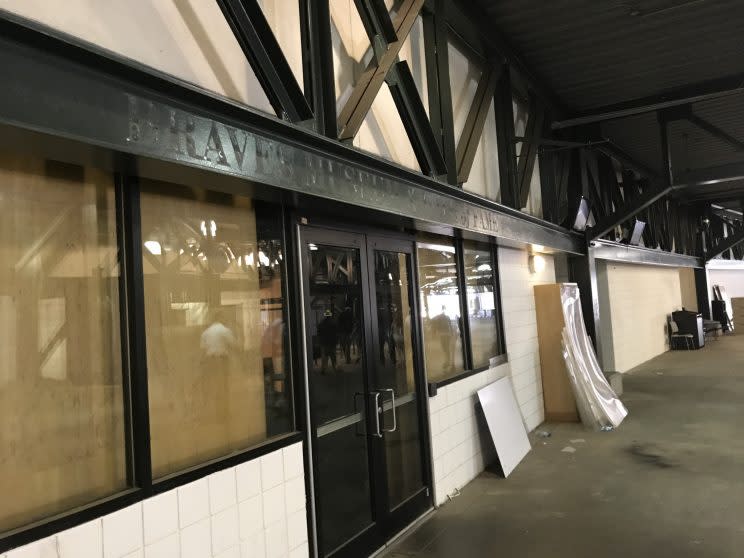
You wouldn’t think that stadiums are disposable commodities. But every single baseball-only stadium replaced by a newer model in the last two decades—Shea Stadium, old Yankee Stadium, old Busch Stadium in St. Louis, Veterans Stadium in Philadelphia, Riverfront Stadium in Cincinnati, Milwaukee County Stadium, Three Rivers Stadium in Pittsburgh, Tiger Stadium—later fell to the wrecking ball. Most of the dual-use facilities, like Minneapolis’s Metrodome and San Francisco’s Candlestick Park, are gone too, reduced to rubble and souvenir seats. (Of course, none of those facilities were just 20 years old when their teams departed, but that’s a discussion for another day.)
So credit the city of Atlanta and Georgia State for coming up with a solution that didn’t involve either abandoning or demolishing a part of the city’s (very recent) history. Turner Field sits on a relatively inaccessible patch of land bracketed by highways; you can catch a glimpse of it in the opening highway scene of “Baby Driver.” Had Georgia State not come through, the stadium likely would have become yet another weed-pocked parking lot in a city that has enough of those already.
Instead—if all goes according to plan—the former Turner Field will become a more integral part of the city under Georgia State than it ever was under the Braves, part of a large complex slated to include new academic buildings and mixed-use development. Georgia State now owns the torch that Muhammad Ali lit to start the 1996 Olympics, one of the more stirring moments in sports history, and plans to give that monument its proper recognition. There are even plans to develop a new baseball stadium on the footprint of the old Atlanta-Fulton County Stadium, the place where Hank Aaron broke Babe Ruth’s career homer record and where the Braves celebrated their 1995 World Series championship.
Shawn Elliott, Georgia State’s new head coach, grew up in South Carolina—he’s best known up till now as the guy who took over when Steve Spurrier bolted the Gamecocks midseason in 2015—and came to the stadium in every incarnation, from its brief tenure as the 1996 Olympics’ centerpiece to all its years hosting the Braves.
“There’s so much history here, that’s one of the most unique things about it,” Elliott said. “We get to be a part of the history in this stadium. I tell the players all the time, ‘The greatest athletes in the world were here. The greatest baseball players in the world were here. And you’re part of that. Let’s write our own history here.'”
It’ll be a fitting new chapter for the stadium and the area. And it all begins on August 31.
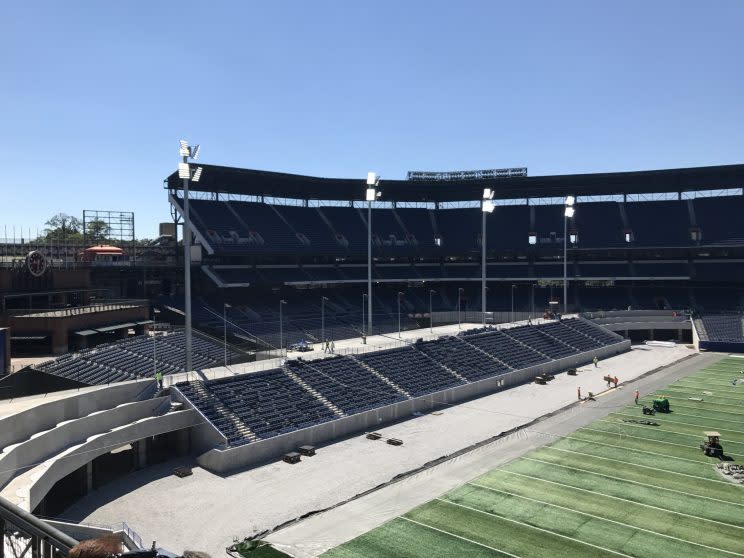
____
Jay Busbee is a writer for Yahoo Sports and the author of EARNHARDT NATION, on sale now at Amazon or wherever books are sold. Contact him at jay.busbee@yahoo.com or find him on Twitter or on Facebook.


